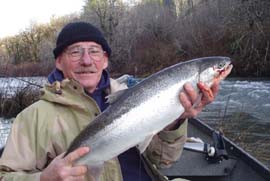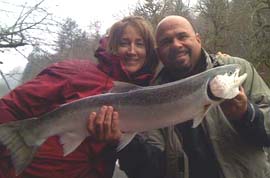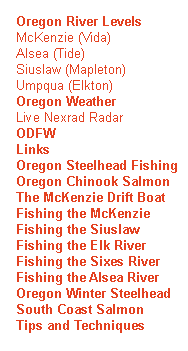




|
|||||
|
|
|||||
 |
Strong
start for Steelhead January 15, 2004 By Mike Stahlberg The Register-Guard |
||||
| ALSEA
- Winter steelhead
don't grow on trees, although there are times along the banks of the North
Fork Alsea River when it certainly appears as though they must.
That's because successful steelhead anglers often drape their catch by the gills over stubby branches - the better to keep the fish out of the mud while they're casting for another one. Several silver piscatorial ornaments, weighing from 6 to 12 pounds, hung in the trees Tuesday morning, and even greater numbers were visible a few days earlier. "About three days ago, it was just red hot," said Brad Littlefield, a fish and wildlife technician at nearby Alsea Hatchery, where more than 1,200 have already returned. That's "a little above average" for this time of year, Littlefield said. Based on a strong start, state fish biologists are looking for winter steelhead fishing to be good to excellent in rivers along the central Oregon coast over the next two months. Anglers were averaging about one fish per boat Sunday on the Siuslaw River, according to George Westfall, an Oregon Department of Fish and Wildlife (ODFW) biologist in Florence. "And a week ago Monday and Tuesday, people just slammed them - guides were limiting out." In addition, Westfall said, the president of the Florence STEP (Salmon Trout Enhancement Program) club recently reported catching a trio of 15-pound steelhead just below Greenleaf on Lake Creek. Such early-January success in a river basin where winter steelhead fishing normally peaks in late February or March "is a good indicator that we're going to have some pretty decent fishing, I think," Westfall said. Fishing in the Siuslaw River and Lake Creek should be "much better than last year," he said, if for no other reason than the number of smolts available to return as "two-salt" adults is almost three times higher this year. Only about 30,000 smolts were in last year's class of first-time spawners. The smolt count for this year's class of two-salts - fish that spend two years in the ocean before returning to spawn - was about 85,000. Ocean conditions were apparently favorable for anadromous fish that went to sea two years ago, Westfall said, "based on the Coho returns we saw." Meanwhile, anglers on the Siletz River have been catching hatchery-produced winter steelhead since early December, according to Bob Buckman, the ODFW district fish biologist based in Newport. "We expect the peak of that fishery to occur from about late January into early March," Buckman said. "So it's just coming on the peak. And we have every reason to think it will be a fairly decent fishery." Winter steelhead fishing, of course, is notoriously susceptible to the rapid fluctuations of river levels associated with winter storms. The Siletz, Buckman said, fishes best when the river gauge reads around 5 feet. "Fishing can occur in the upper river when the gauge is as high as 7 feet, and when it gets down to 4 feet fishing can be very good in the lower river," Buckman said. (Current and projected river levels for many Oregon waterways are available on the Internet at www.nwrfc.noaa.gov.) A good place to start fishing the Siletz is the area around Moonshine Park, where the hatchery fish are released as smolts and where they attempt to return as adults. Hatchery steelhead are also released in the Yaquina River, but those are an early-returning strain and "we're already getting toward the tail end of that fishery," Buckman said. The Alsea River has a reputation as an "early-start, early-end" steelhead river, but Buckman expects it to be productive longer into the spring from now on, due to a change in the stocking program. The traditional Alsea brood stock developed in the 1930s is being supplemented by smolts that are the progeny of "wild" steelhead, which tend to return to the river later in the season. The wild brood stock is collected by anglers who volunteer for the project. "This year, for the first time, we're getting two-salt returns from the wild brood stock," Buckman said. Both strains of steelhead are marked with the clipped adipose fin that designates a hatchery fish. But the traditional stock also has a clipped left maxillary, while the new strain has a marked right maxillary. "The fishery on the traditional Alsea stock is usually fading by late January," Buckman said. "We expect the new brood stock component to spread the fishery out through March." Boat fishing from the town of Alsea downstream is "best when the river's at 5 to 6 feet," Buckman said. "And it can be good in the lower part of the river at flows down to about 3.5 feet. When flows are higher, fishing can be very good on the North Fork." That was the case over the weekend, as the North Fork dropped back into shape following the runoff associated with last week's storms. The stretch of river just below the hatchery intake - no fishing is allowed within 100 feet of that - is so popular anglers sometimes find themselves standing almost shoulder-to-shoulder. "It can get pretty crowded there, so anglers are reminded to be respectful of other fishermen and private property ("No Trespassing" signs are posted on some sections of the river bank)," Buckman said. For winter steelhead anglers who want to avoid the crowds, Buckman points out that the mid-coast is home to "several streams that are not stocked with hatchery fish but provide good catch-and-release opportunities on wild fish. Those include the Yachats River, Ten Mile Creek, Big Creek and Cape Creek. "Salmon River is also catch-and-release and gets a good run," he said. And a pair of Drift Creeks - one in the Siletz basin, the other in the Alsea - provide good catch-and-release bank fishing opportunities in February and March. Meanwhile, to the south, the Tenmile Lakes, Coos and Coquille basins have also been very good to excellent for winter steelhead, according to ODFW reports. Tenmile Creek angling access is available at Spinreel Park, and success rates there are usually good - mainly because steelhead smolts are acclimated and released at the mouth of Saunders Creek in the park and adult hatchery steelhead are drawn back to this area. Steelhead angling "is excellent in the Coos Basin," according to the latest ODFW angling report, with "hatchery steelhead plentiful at this time" in the East and West Millicoma rivers. Recommended areas to fish those waters for fin-clipped "keepers" include the first five miles above tidewater (located at Dellwood) on the South Coos River. Smolts are acclimated and released at Big Creek, near milepost 5. (Access to the South Coos River above Dellwood is by free permit from Weyerhaeuser Co., and is subject to the company's rules.) On the East Fork Millicoma, bank access with several excellent fishing holes and drifts is available in Nesika County Park. On the West Fork, public access is available about nine miles from the river mouth, near ODFW's Millicoma Interpretive Center. Ponds at the center are used for acclimation of steelhead smolts, so adult fish are drawn back to that area of the West Fork as well. Finally, fishing in the Coquille Basin is also off to a promising start, with "steelhead plentiful in all forks of the Coquille," state fish biologists report. "Water levels are high, but fish are being caught where conditions allow." Some of the best fishing in the Coquille Basin is below the town of Powers, near acclimation sites at Beaver Creek and Woodward Creek. Also, there is an excellent catch-and-release fishery on unmarked wild fish that move upstream of Powers. Special Thanks to Mike Stahlberg for permission to
post this article |
|||||